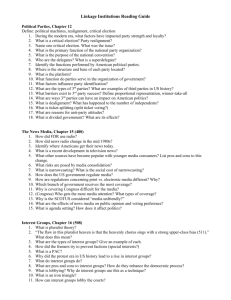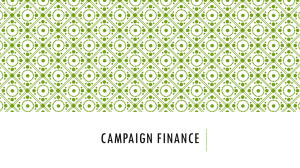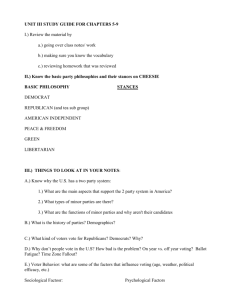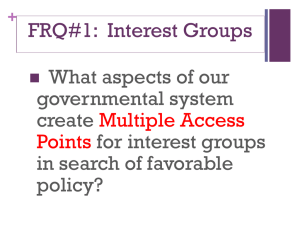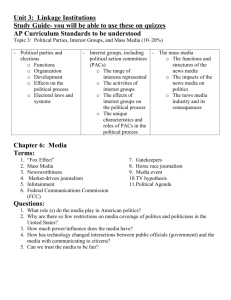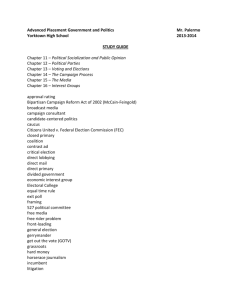CAMPAIGN FINANCE REFORM
advertisement
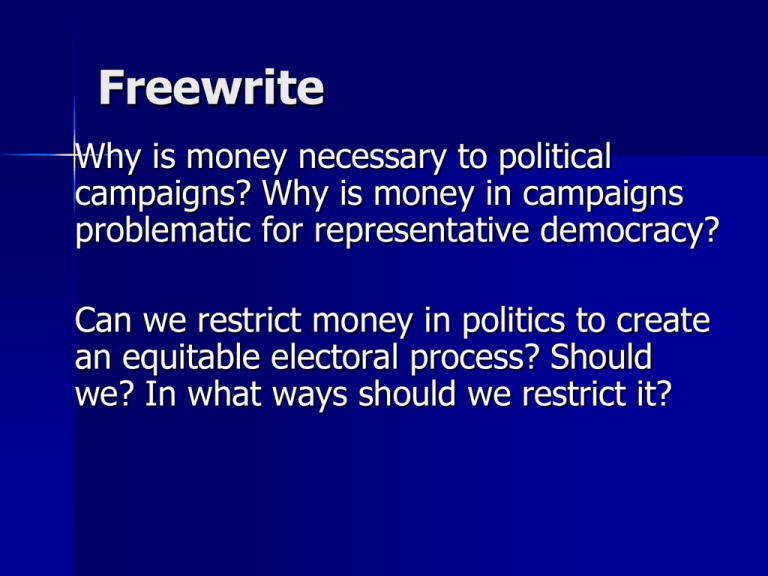
Freewrite Why is money necessary to political campaigns? Why is money in campaigns problematic for representative democracy? Can we restrict money in politics to create an equitable electoral process? Should we? In what ways should we restrict it? CAMPAIGNS: SEASON, MONEY, MEDIA EARLY HISTORICAL BACKGROUND First 50 years-costs are low--small pop., only white male property owners could vote: 1 out of 5 adults cheap election costs The history involves 3 issues: •public disclosure of funds •restrictions on contributions •public financing of Presidential campaigns The history involves 6players: •parties, media, interest groups, PACS , FEC, Courts, Congress The history involves 1 big question: Is money protected by the First Amendment? The Growth of “Boodle” 19th century changes – expansion of rights and enfranchisement – industrialization – big interest groups emerge: industry, labor – Democratic reforms increase pressure: 17th, 19th Amendments – hyperpluralism Attempts at Reform Before 20th Century – focus on political participation In the 20th Century efforts focus on the campaign process itself Zig Zag path of Reform 1905: Teddy Roosevelt “all contributions by corporations to any political committee or for any political purpose should be forbidden by law.” 1907--Tillman Act, 1910 and 1925 Federal Corrupt Practices Acts: set spending limits for House/Senate Campaigns and disclosure laws ALL: weak enforcement! Zig Zag path of Reform 1944: AFL-CIO form first PAC, or Political Action Committee Congress: – 1971 FECA: repeals FCPA and creates updated framework for regulation of campaign financing--$, advertising, disclosure – 1974 Amendment: abolishes limits on media advertising and establishes the FEC Courts: 1976: Buckley v. Valeo: keeps FEC, disclosure laws, but strikes down as unconstitutional limits on candidate spending on their own campaign Buckley on spending limits Can’t limit Independent Expenditures – “The concept that government may restrict the speech of some elements of our society in order to enhance the relative voice of others is wholly foreign to the First Amendment.” Can’t limit Candidate Personal expenditures – “The candidate, no less than any other person, has a First Amendment right to engage in the discussion of public issues and vigorously and tirelessly to advocate his own election and the election of other candidates.” Can’t limit Overall Campaign expenditures – “The major evil associated with rapidly increasing campaign expenditures is the danger of candidate dependence on large contributions. The interest in alleviating the corrupting influence of large contributions is served by the act’s contribution limitations and disclosure provisions rather than by campaign expenditure ceilings.” Buckley and TV ads Buckley, among other things, established the difference between: – express advocacy ads: ads that show “electioneering” language, and directly communicate a message to support or reject a candidate: used by political parties, etc. – “Magic Words” test – express ads-subject to federal regulation – issue advocacy ads: ads that neither directly promote or reject candidates: used by 501 groups, etc. – issue ads: not subject to federal regulations Buckley v. Valeo Upholds disclosure requirements Strikes down spending limits because they interfere with first amendment freedoms Upholds contribution limits Upholds presidential public financing because expenditure limits are voluntary Soft Money Dance 1979: Carter: 1991: FEC Congress: 1996: McCain-Feingold--ban signs law to allow unlimited soft money contributions for “party-building activities” requires parties to disclose soft money contributions PACs and offer financial incentives, later--limit soft money Bipartisan Campaign Finance Reform Act of 2002 (BCRA) Bans national party soft money Limits state party soft money Raises hard money limits Millionaire amendment Ad limits Hard Money limits under BCRA Individuals: – Can give $2,000 per candidate per campaign – Can give $25,000 to a party, per year – Can give a maximum of $95,000 to candidates, parties, and PACs PACs: – Still can give $5,000 to each candidate – Still can give $15,000 to each party – No limit on overall contributions How does money influence today’s elections? BCRA 2002: $2,000 individual cap (matchable); $5,000 PAC Cap – Ergo: get as many individual donors as possible – Ergo: the little guy can still matter – Ergo: internet serves as a great interface between the party organization and the voter Controversy: is a campaign donation considered an “act of speech” --speech Bush Administration •2000 election: both parties raise up to $500 million •2002 Bush signs legislation: bans national party committees and federal office holders from soliciting soft money •May 2003 3 judge Fed. Court struck down most of the ban Top Ten Democratic 527s in 2004 America Coming Together - NonFederal Account 79,795,487 Joint Victory Campaign 2004 71,811,666 The Media Fund 59,404,183 Service Employees International Union Political Education & Action Fund 48,426,867 AFSCME Special Account 25,144,915 MoveOn.org Voter Fund 12,558,215 New Democrat Network Non Federal Account 12,726,158 Citizens for a Strong Senate 10,853,730 Sierra Club Voter Education Fund 87,271,27 EMILYS List Non Federal 77,399,46 Top Ten Republican 527s, 2004 Progress for America Voter Fund 44,929,178 Swift Boat Vets and POWs for Truth 25,758,413 Club for Growth 19,365,903 College Republican National Committee, Inc. 16,830,651 Club for Growth.net 4,115,037 National Association of Realtors 527 Fund 3,215,263 The November Fund 3,151,170 CA Republican National Convention Delegation 2004 Account 4,393,055 Republican Leadership Coalition, Inc. 2,365,550 National Federation of Republican Women 2,201,533 “Working Together” Federal Candidate Committee (FEC) – e.g, Jones for President Campaign Committee National Party State Parties (FEC) – Democratic National Committee Election Comm) Virginia – Local Parties PACs Election Comm) (FEC & State Democratic Party of (FEC & State – Connected PACs – Unconnected PACS – SuperPacs Individual contributors 527s Connected PACs n the 2008 elections, the top nine PACs by money spent by themselves, their affiliates and subsidiaries were as follows: International Brotherhood of Electrical Workers PAC $3,344,650 AT&T Federal PAC $3,108,200 American Bankers Association (BANK PAC) $2,918,140 National Beer Wholesalers Association PAC $2,869,000 Dealers Election Action Committee of the National Automobile Dealers Association $2,860,000 International Association of Fire Fighters $2,734,900 International Union of Operating Engineers PAC $2,704,067 American Association for Justice PAC $2,700,500 Laborers' International Union of North America PAC $2,555,350 McConnell v. FEC Upholds soft money ban. The governmental interest underlying §323(a).preventing – “The actual or apparent corruption of federal candidates and officeholders constitutes a sufficiently important interest to justify contribution limits. …The idea that large contributions to a national party can corrupt or create the appearance of corruption of federal candidates and officeholders is neither novel nor implausible.” Upholds hard money restrictions on issue ads. – “Although the . . . advertisements do not urge the viewer to vote for or against a candidate in so many words, they are no less clearly intended to influence the election." Supreme Court June 2003 5-4 ruling! – McConnell v. FEC – “coordinated expenditures” to campaigns subject to FEC limits – BUT: soft money spent by parties independent of candidate campaigns is o.k. – minority: Kennedy, Rehnquist, Scalia, Thomas Citizens United vs. FEC Overrules McConnell in part: – Overrules the ban on independent expenditures paid for by corporations or unions out of their treasuries 60 days before an election Overturns ban on independent expenditures from corporate and union treasuries – "If the First Amendment has any force, it prohibits Congress from fining or jailing citizens, or associations of citizens, for simply engaging in political speech," - Justice Kennedy Effects of Polispots Perceptions of candidates can be changed Costs of campaigning skyrocket Traditional parties are weakened; money wins out Voter cynicism The Iron Law: Politicians must be able to handle the media Campaign Ads The goal: reinforce, activate, and convert voters Polispots and their stages: miss one stage, you lose the election! Stage 1: Identification—Who am I? (background and qualifications) Stage 2: Arguments-What is my position? (position on different issues) Stage 3: Attack—What’s wrong with my opponent? Stage 4: Future “ I see an America…” (visionary, hopeful) Heading off the Attack Ad Late defense Inoculation Some examples 1988 Election: Willie Horton Ad: http://www.youtube.com/watch?v=EC9j6Wfdq3o 2000 Election: Ralph Nader Ad http://www.youtube.com/watch?v=tH4VCtAQcP4 2004 Election: Kerry Windsurfing Ad http://www.youtube.com/watch?v=pbdzMLk9wHQ 2004 Election: Bush Cheney http://www.youtube.com/watch?v=2iPnvACXXV0 1980 Election: Ronald Reagan http://www.youtube.com/watch?v=EU-IBF8nwSY 2008 Election: Mitt Romney http://www.youtube.com/watch?v=X2HsaCqLzA0 2000 Election AD: George Bush http://www.youtube.com/watch?v=vULB2jtmlyw 2006: Bill Richardson http: //www.youtube.com/watch?v=X0juSJ-y9xg Barack Obama http://www.youtube.com/watch?v=1DLNsFjFGCI
